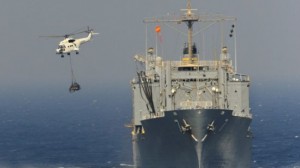 A US Naval vessel and helicopter in the Persian Gulf[/caption]
A US Naval vessel and helicopter in the Persian Gulf[/caption]Iran was once on a path of liberalization and reform before the US Military began sowing destruction throughout the Middle East and Central Asia following the attacks on the United States in 2001.
Although now largely forgotten, the last president of Iran, Mohammad Khatami (1997-2005), was a liberal-minded reformer who fought for freedom of expression, tolerance and civil society. He was open-minded about building diplomatic relations with other states, including those with which Iran has had problems in the past.
He even waged something of an intellectual battle against American academic Samuel Huntington, who argued on behalf of a��clash of civilizations.��Khatami advanced the concept of��dialogue among civilizations,��which seemed the more promising and peaceful idea. The former Iranian president�s proposal became so popular that the United Nations proclaimed the year 2001 as the United Nations'�Year of Dialogue among Civilizations.�
Eventually, however,��clash��trumped��dialogue��as America�s reckless��War on Terror��seemed to recognize no clear boundaries, and even less good judgment.
For the past decade, Tehran has watched with increasing apprehension as a US-led coalition has launched a series of military offensives throughout the region, most notably in bordering Afghanistan and Iraq, as well as a highly controversial drone campaign inside of Pakistan.
It came as little surprise that Khatami�s liberal policies began to fall out of favor as the Islamic Republic was forced to confront the specter of US military might massing on its borders.
Khatami�s liberal agenda was overshadowed by a relative unknown, Mahmoud Ahmadinejad, the conservative hardliner who was elected to the presidential post with a stunning 17,046,441 votes out of a total of 27,536,069 cast in the runoff election. Ahmadinejad�s two-term presidency (the maximum permitted by Iran�s constitution) will come to an end in June as Iranians prepare for presidential elections.
Judging by the way the US Military is entrenching itself in Iran�s immediate neighborhood, it will be interesting to see who replaces Ahmadinejad. The Iranian President has declared his support for his Chief of Staff Esfandiar Rahim Mashaei, who has been described as a fervent��religious-nationalist.�
Iran's present political trajectory does not promise to change much, since the top eight contenders for the presidential post have been described as��hardline conservatives.��Thus, any hope that the upcoming elections will produce a candidate who will be willing to sit down and talk with Iran�s enemies (much as US President Barack Obama pledged to do on the dusty campaign trail) do not look very promising.
Given the ideological conformity of this year�s presidential candidates, who have been vetted by the Guardian Council � a 12-member council of senior clerics and judges whose task it is to��safeguard the constitution��� it looks doubtful that there will be any repeat of the problems that hampered the 2009 presidential elections.
Following accusations by the opposition that the voting was rigged, supporters of main opposition leader Mir-Hossein Mousavi took to the streets to vent their anger. After nearly a week of tensions, Supreme Leader Ayatollah Ali Khamenei endorsed Ahmadinejad's 2009 bid, saying the vote difference was too large to have been manipulated.
It remains a matter of speculation as to what degree the US Military�s activities in the region have altered Iran�s political landscape.
Although the Pentagon has said it will start withdrawing its troops from Afghanistan next year, the long-awaited drawdown comes with a catch: Uncle Sam wants to keep nine military bases operational in the country for an indefinite period. That�s a very large military footprint. Earlier this month, Afghan President Hamid Karzai agreed to Washington�s demands, if they were ever his to refuse.
Much the same could be said for Iraq, which endured NATO occupation for almost 9 years.
�The military pullout a year ago� did not end Washington's engagement,��AP reported.��The US Embassy in Baghdad, a fortress-like campus as big as Vatican City, remains a highly visible reminder of America's ongoing interest in Iraq's future.�
America's de facto role as Iraq's biggest arms supplier guarantees a high level of US military oversight in the country for years to come. Now add to Afghanistan and Iraq the US naval presence in the Persian Gulf, and Iran is quite literally surrounded by US firepower.
Meanwhile, tensions over Iran's nuclear program continue to ebb and flow.
Last year, as the possibility of a unilateral Israeli attack on Iran over its alleged nuclear weapons program seemed plausible, Iran threatened to shut down the Strait of Hormuz, through which 18 million barrels of oil � roughly 35 percent of the world�s total � flows every day.
It goes without saying that any disruption of this supply route would have a huge impact on oil prices, and by extension the global economy.
In September, the United States was at the helm of a 12-day, 25-nation naval exercise in the Persian Gulf. Though these war games are conducted annually, last year�s games were clearly an effort to intimidate Tehran: Three full US carrier groups participated in the exercises, each accompanied by dozens of support vessels and carrying more aircraft than the entire Iranian air force.
Earlier this month, another US-led naval drill began in the Persian Gulf in a second such display of maritime strength in less than a year. The exercises involved 35 ships, and 18 unmanned submarines and aircraft.
Whether a new Iranian president can resolve the simmering crisis remains to be seen, but the odds, it seems, are not encouraging.
By Russia Today
The Iran Project is not responsible for the content of quoted articles.










